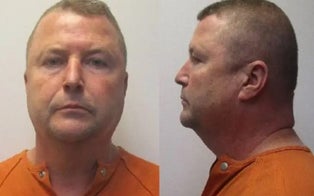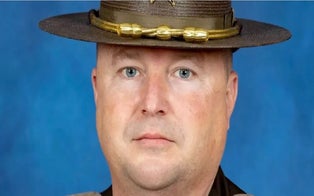Take a look back at one of the stories that helped launch an era of true crime obsession.
He was the dark and handsome high school football player. She was an athletic student with good grades and a lot of friends. Their young love story began with an invitation to the prom and ended with a shocking murder that left the city of Baltimore reeling for years.
Now, the tumultuous relationship of Hae Min Lee and her convicted killer Adnan Syed has been cast into the canon of true crime stories 20 years later.
New attention was fixed on the 1999 case with the explosive podcast "Serial" in 2014. The show hooked listeners as host Sarah Koenig retraced Adnan and Hae's steps around Baltimore, raising questions about whether a Muslim teen was capable of strangling his high school sweetheart and dumping her body in a seedy city park. "Serial" became the fastest podcast ever to reach 5 million downloads on iTunes, according to Apple.
The fascination with Adnan and Hae has only continued. A new HBO docu-series called "The Case Against Adnan Syed" is set to premiere March 10 and promises to probe deeper for the answers to lingering questions in the case that is still being fought in the courts today.
Take a look back at one of the stories that helped launch an era of true crime obsession.
Two Friends Fall in Love
In 1998, Adnan and Hae were students at Woodlawn High School outside of Baltimore. The two were classmates and friends — both athletic, smart and outgoing. After attending the prom together, as teenagers do, the two fell into an intense relationship. Hae wrote often in her diary about her new boyfriend, admitting in one entry, "I think I might just love him." And Adnan returned the passionate affection, writing in a poem for his girlfriend, "I cherish this love that I have found ... Hae Lee, no doubt she's my pyar (love)."
But the challenges of the ill-fated relationship soon arose, according to Syed family friend Rabia Chaudry, who wrote extensively about the case in her book "Adnan's Story: The Search for Truth and Justice After Serial."
Adnan's parents had immigrated from Pakistan and his family practiced Islam. Any romantic relationships outside of marriage were off-limits for Adnan. And Hae came from a traditional family as well. She was born in South Korea before she immigrated to the U.S. with her mother and brother to live with her grandparents. Hae wrote in her diary about her discomfort of coming between Adnan and his Muslim faith.
The pair continued to see each other for the next 10 months, though, talking in secret phone calls and sneaking off to meet. But eventually, someone did end up coming between Adnan and Hae. It wasn't a family member, but another boy. In December 1998, Hae broke up with Adnan and pursued a relationship with a boy she worked with at LensCrafters at the local mall.
Moving On?
According to Chaudry, Adnan was sad that he could no longer be with Hae, but the two remained friends after their breakup, even still talking on the phone. One day at the end of December, Hae called Adnan after experiencing some car trouble. When he went to help her, he came face-to-face with Don, Hae's new crush, but the meeting carried on amicably.
Hae and Don soon began a relationship, much like hers and Adnan's. The two talked on the phone late and visited each other often. On Jan. 12, the day before Hae would go missing, Hae and Don spent the evening at his house. Don later told investigators that Hae was in a good mood but had said she was fighting with her mother.
After returning home, Hae was on the phone with Don when she received a call from Adnan. She took the call and, according to Chaudry, asked Adnan a haunting question: Would they ever get back together? Adnan didn't think so, saying they were better as friends.
Hae returned to her call with Don, who would tell investigators that they stayed up talking until 3 a.m. "I love you Don," Hae wrote in her journal after hanging up.
They would be the last words Hae would write in her diary.
Hae Disappears
On Jan. 13, 1999, Hae was supposed to pick up a cousin after school. But when she didn't show, her family called the police.
The responding officer wrote in a report that Hae's grandmother said she saw the teen leave for school that morning. After speaking to Adnan and Hae's friend Aisha Pittman, the officer wrote that both said they saw Hae at school during the day.
According to the report, Adnan told the officer that Hae had agreed to give him a ride home after class. However, Adnan said according to the report, he was running late and assumed Hae left without him, so he didn't get the ride.
Hae's manager at LensCrafters told the officer that Hae never showed up for her shift that day and hadn't contacted the store. Don told the officer he didn't know where Hae was either.
Hae's brother told the officer, according to the report, that Hae had never done anything like this before and that her "family life is good."
A Shallow Grave
Hae's body was found almost four weeks later on Feb. 9 when a man spotted her while walking in Leakin Park, a seedy area outside the city known as a dumping site for homicide victims. The man came across Hae's body in a shallow grave about 100 feet in, just a mile from Woodlawn High School.
The discovery of Hae's body in Leakin Park was not lost on police. Investigators said immediately that the case was being investigated as a homicide because of the location of Hae's resting place and the nature of her corpse.
Though her body showed no immediate signs of trauma, investigators later determined that Hae had been strangled.
All Eyes on the Ex-Boyfriend
On Feb. 12, an anonymous tipster told police to look into Hae's ex-boyfriend — Adnan — and officials closed in.
Police contacted an acquaintance of Adnan's, Jay Wilds, and asked him about Hae's disappearance and her relationship with her ex-boyfriend. Jay eventually provided police with a story that prosecutors would rely on to help convict Adnan of Hae's murder, despite there being no physical proof to back up his claims.
Jay said Adnan had been angry that Hae left him and he talked about wanting to kill her. Then on Jan. 13, Jay said, Adnan skipped the last period at school, and they were hanging out in Adnan's car. Adnan lent Jay his car for the afternoon, and they parted ways. When Adnan later called Jay to pick him up, Jay said that Adnan said he strangled Hae. Adnan showed him her body in the trunk of her car, Jay said, and asked Jay to help him bury the body. Jay agreed, he said, and the two buried Hae's body in Leakin Park. Jay also told police where Hae's car was left.
Even though there wasn't any physical evidence linking Adnan to the murder itself, police ran on Jay's story. The details changed with each telling, but Adnan was arrested on Feb. 28 and later charged with Hae's murder.
Jay was later charged with being an accessory after the fact. He was found guilty and received two years of probation.
The Trials
The Syed family hired high-profile criminal defense attorney Cristina Gutierrez to represent Adnan, who asserted his innocence and maintained he didn't kill Hae. His trial began on Dec. 8 and lasted for eight days. After the jury overheard an argument between the judge and Gutierrez, the judge declared a mistrial on Dec. 15, and Adnan was set to get a new trial.
Adnan's second trial, again with Gutierrez as his attorney, began on Jan. 10, 2000. This second trial lasted six weeks and, after the jury deliberated for only two hours, Adnan was found guilty of first-degree murder, kidnapping and robbery on Feb. 25. Adnan was sentenced to life in prison.
Alibi Ignored?
Adnan made his first appeal in 2003 but was denied. In 2010, he motioned for a post-conviction relief on the basis of ineffective assistance of counsel, claiming that Gutierrez failed to investigate an alleged alibi. A classmate of Adnan's, Asia McClain, had said she was with Adnan in the school library at the time police said Hae was murdered. But Gutierrez never contacted her.
In the summer of 2016, Adnan had a new lawyer and a Baltimore City Circuit Court judge granted him a new trial, vacating his 2000 conviction. The judge based his decision on key evidence the prosecution used. Prosecutors claimed data logged from cellphone towers in the area showed that Adnan was at the locations named in their story of how and when Hae was killed. However, Adnan's new lawyer argued that cell data was unreliable in determining a person's location. The judge agreed, saying Gutierrez was ineffective for failing to cross-examine the state's evidence.
The judge also said Gutierrez was deficient for not contacting Adnan's alleged alibi witness, but he said her decision did not hurt his trial. When Adnan's lawyer asked for him to be released on bail until his new trial began, the judge denied the request, and Adnan remained in prison despite his vacated conviction.
Gutierrez was later disbarred and died in 2004.
In 2018, the state appealed the decision to Maryland's highest court.
Guilty Again
On March 8, 2019, the Maryland Court of Appeals struck down the lower court's 2016 opinion and ruled that Adnan would not get a new trial. The court reinstated his 2000 conviction, saying that while his defense was deficient, it “did not prejudice” the case.
“We agree with the conclusion of the Court of Special Appeals that Mr. Syed’s trial counsel’s performance was deficient under the Strickland v. Washington standard in failing to investigate the alibi witness,” the four judges on the court wrote in their conclusion. “We disagree, however, with that court’s conclusion that Mr. Syed was prejudiced by his trial counsel’s deficiency.”
In the dissenting opinion, three of the judges wrote they believed the deficiency was, in fact, prejudicial against Adnan and his defense.
Following Friday’s ruling, Justin Brown, Syed’s attorney, tweeted: “We will not give up. #FreeAdnan.”
McClain, who testified at the post-conviction hearing in 2016 before Adnan was granted a new trial, tweeted her reaction on Friday, writing "No words" along with two videos that showed her in tears. She also tweeted the hashtag #WhatAboutAdnan?
RELATED STORIES






